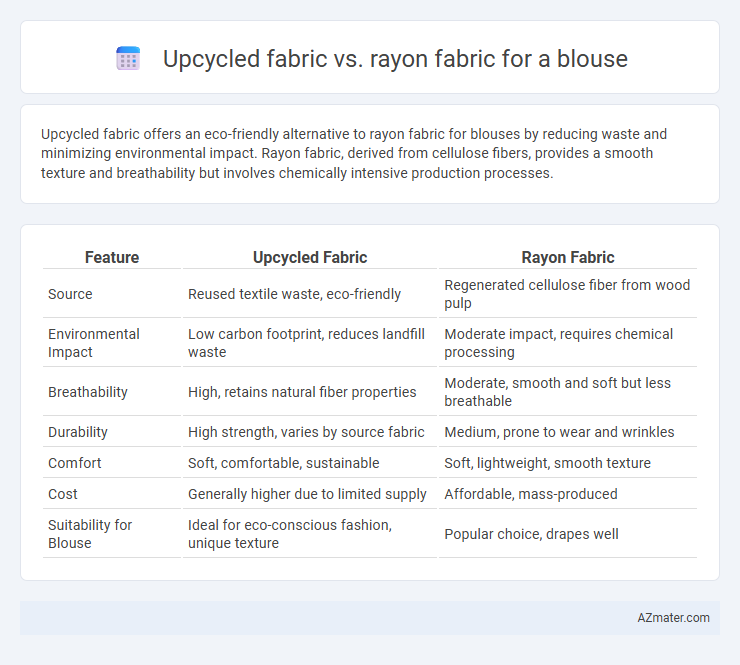Upcycled fabric offers an eco-friendly alternative to rayon fabric for blouses by reducing waste and minimizing environmental impact. Rayon fabric, derived from cellulose fibers, provides a smooth texture and breathability but involves chemically intensive production processes.
Table of Comparison
| Feature | Upcycled Fabric | Rayon Fabric |
|---|---|---|
| Source | Reused textile waste, eco-friendly | Regenerated cellulose fiber from wood pulp |
| Environmental Impact | Low carbon footprint, reduces landfill waste | Moderate impact, requires chemical processing |
| Breathability | High, retains natural fiber properties | Moderate, smooth and soft but less breathable |
| Durability | High strength, varies by source fabric | Medium, prone to wear and wrinkles |
| Comfort | Soft, comfortable, sustainable | Soft, lightweight, smooth texture |
| Cost | Generally higher due to limited supply | Affordable, mass-produced |
| Suitability for Blouse | Ideal for eco-conscious fashion, unique texture | Popular choice, drapes well |
Introduction to Upcycled and Rayon Fabrics
Upcycled fabric for blouses is crafted from repurposed textile waste, reducing environmental impact and promoting sustainable fashion. Rayon fabric, a semi-synthetic fiber derived from cellulose, offers a soft, breathable texture and a lightweight feel ideal for comfortable wear. Choosing between upcycled and rayon fabrics involves balancing eco-friendliness with the smooth drape and versatility of traditional fibers.
What Is Upcycled Fabric?
Upcycled fabric is material repurposed from pre-existing textiles, reducing waste and promoting sustainable fashion by transforming discarded fabrics into new, high-quality blouse textiles. Unlike rayon, a semi-synthetic fiber derived from cellulose, upcycled fabric leverages existing resources, minimizing environmental impact by avoiding the energy-intensive production processes characteristic of rayon manufacturing. Using upcycled fabric for blouses supports eco-friendly practices while offering unique textures and patterns not typically found in conventional rayon fabrics.
Understanding Rayon Fabric
Rayon fabric is a versatile semi-synthetic fiber made from regenerated cellulose, primarily derived from wood pulp, offering a soft and breathable texture ideal for blouses. It drapes well and provides a silky feel, making it a popular choice for stylish and comfortable garments. However, rayon is less durable when wet and may require careful washing to maintain its quality compared to upcycled fabrics, which emphasize sustainability by repurposing existing materials.
Environmental Impact: Upcycled vs Rayon
Upcycled fabric significantly reduces environmental impact by repurposing existing materials, thereby minimizing textile waste and lowering resource consumption compared to rayon fabric, which is derived from wood pulp and involves chemically intensive processing. Rayon production often contributes to deforestation, water pollution, and high energy usage, making it less eco-friendly than upcycled alternatives. Choosing upcycled fabric for blouses supports sustainability through waste reduction and decreased reliance on virgin raw materials.
Durability and Longevity Comparison
Upcycled fabric offers enhanced durability and longevity due to its reuse of high-quality fibers already broken in, reducing wear and tear compared to new materials like rayon fabric. Rayon, a semi-synthetic fiber made from cellulose, tends to have lower durability and can weaken or lose shape over time with frequent washing and exposure to moisture. Choosing upcycled fabric for blouses results in garments that maintain structural integrity and resist deterioration longer than typical rayon counterparts.
Comfort and Feel of Each Fabric
Upcycled fabric for blouses offers a unique, textured feel, often softer due to the reclaimed natural fibers, providing a breathable and environmentally friendly option that improves with wear. Rayon fabric boasts a smooth, silky texture with excellent drape and moisture-wicking properties, delivering exceptional comfort and a lightweight, cool feel ideal for warm weather. Both materials prioritize comfort, but upcycled fabric emphasizes sustainability and natural softness, while rayon highlights sleekness and fluidity against the skin.
Style and Design Versatility
Upcycled fabric offers unique, one-of-a-kind patterns and textures that enhance blouse designs with sustainable creativity and visual interest. Rayon fabric boasts smooth drape and vibrant color retention, providing blouse styles with a classic, flowy silhouette and adaptability to various prints and finishes. Both materials support diverse design possibilities, but upcycled fabric emphasizes eco-conscious fashion statements while rayon ensures consistent elegance and comfort.
Cost and Accessibility
Upcycled fabric offers a cost-effective and eco-friendly alternative to rayon fabric for blouses, often sourced from surplus textiles at lower prices. Rayon fabric, while widely available and known for its smooth texture and breathability, tends to be more expensive due to its synthetic production process. Accessibility of upcycled fabric can vary locally depending on textile recycling initiatives, whereas rayon remains readily accessible through mainstream garment suppliers.
Care and Maintenance Tips
Upcycled fabric blouses require gentle washing with mild detergents and should be air-dried to maintain the fabric's integrity and environmental benefits, while rayon fabric blouses demand cold water washes and should never be tumble-dried to prevent shrinking and fiber damage. Both fabric types benefit from low-heat ironing or steaming; however, rayon's moisture sensitivity means extra caution is necessary to avoid warping. Proper care extends the lifespan of each fabric, preserving comfort and appearance for sustainable wardrobe choices.
Which Blouse Fabric Is Right for You?
Upcycled fabric offers a sustainable and eco-friendly choice for a blouse, often featuring unique textures and patterns derived from repurposed materials, making it ideal for environmentally conscious consumers. Rayon fabric provides a smooth, breathable, and lightweight option with excellent drape and softness, suitable for those seeking comfort and elegance in everyday wear. Choosing between upcycled fabric and rayon depends on your preference for sustainability and uniqueness versus comfort and versatility in blouse styling.

Infographic: Upcycled fabric vs Rayon fabric for Blouse
 azmater.com
azmater.com